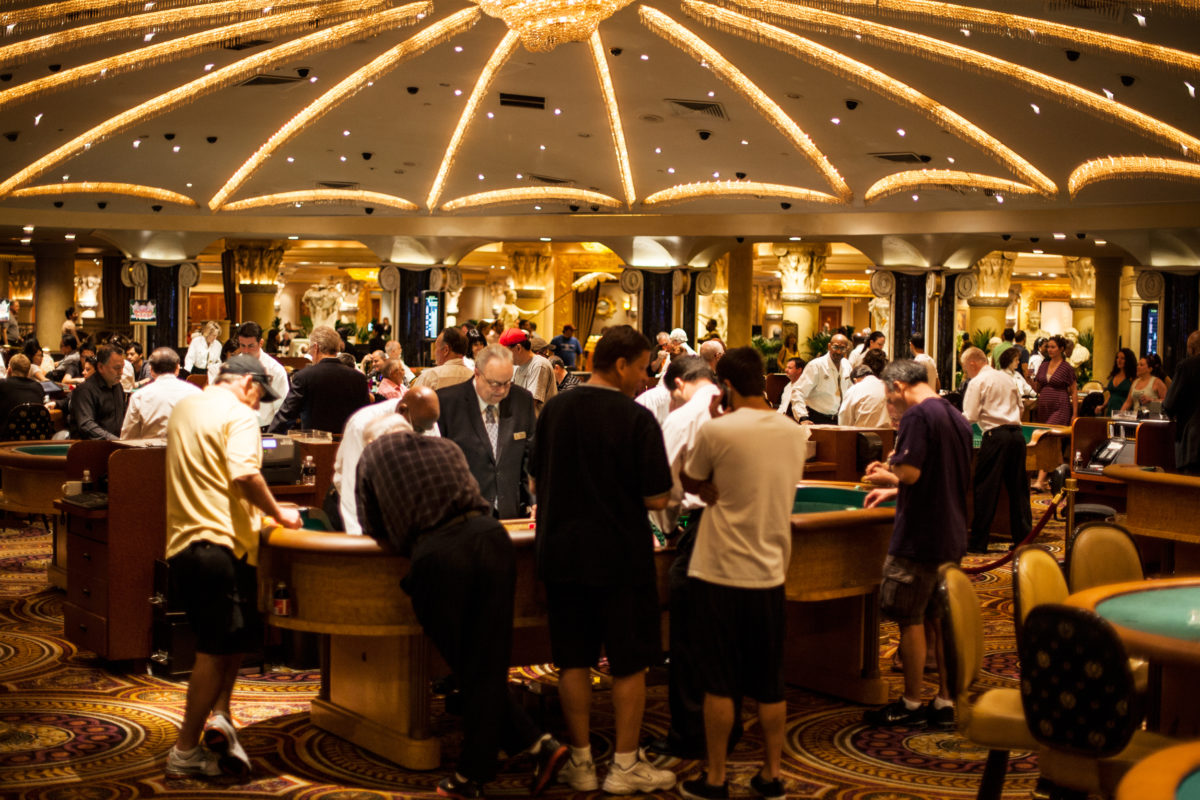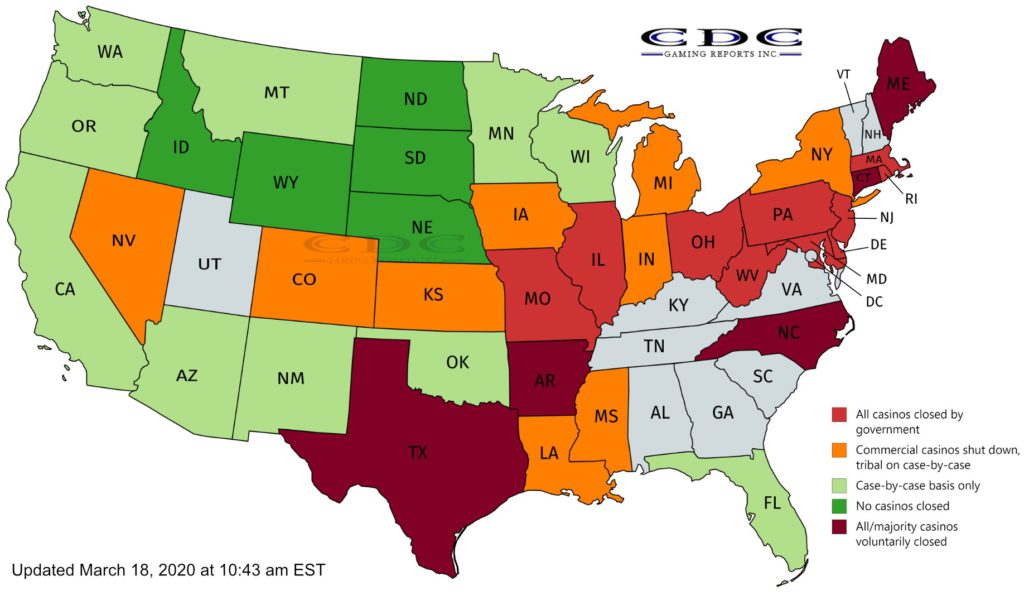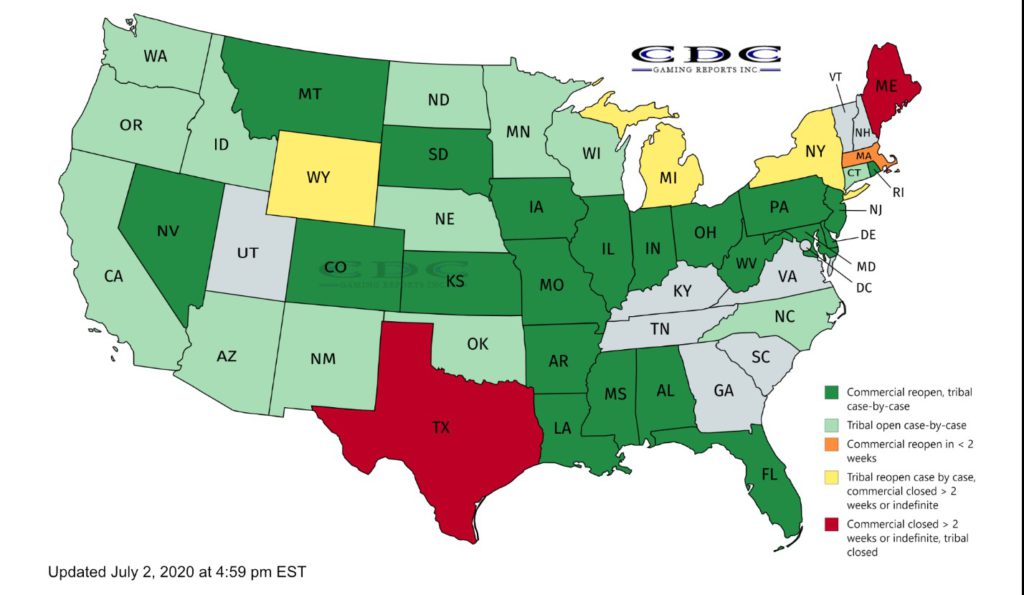
Looking Back: Life In Limbo, The Covid-19 Blues, Change & Resilience As A Casino Employee
By Michael P. Johnson
March 11, 2021, marked the 1st anniversary of Covid-19 being labeled a “pandemic.” A year ago, the casino industry was turned on its ear, having to shut down. Looking back on it now, as a casino professional with a family to think about, it wasn’t easy to wrap your head around it. It wasn’t too long after this time, just one year ago, where we were asked to leave. At first, it was for two weeks, then indefinitely, because no one knew when this pandemic would end.
The map below represents casino closings in the U.S. on March 18, 2020.

It was frightening for a lot of casino professionals. Making sure your family was safe was of the highest priority. Having a wife whose immune system is weakened and a one-year-old daughter put things in perspective for me. Having no contact with anyone was something new to get used to. Making sure our elderly parents were taken care of during a pandemic was something to be concerned about.
After eight weeks of being furloughed, being called back to my casino job was both a blessing and a curse. Many felt the same way. There was a feeling of, “You wanted to go back to work, sure, but at the same time, you were worried about catching Covid-19 and bringing it home to your family.”
You had to be careful, practice social distancing, and wear your mask.
The map below represents casino closings in the U.S. on July 2, 2020. As you can see, from the map above and the one below, in three and a half months, casino openings increased substantially.

When going to the casino for the first time after closing due to a pandemic, you’re going to see some changes. The following list is only some, but probably the most noticeable changes one will see:
- Reduced hours of operation – Being open only 20 hours per day has its advantages. For instance, those four hours a day where there are no patrons helps the cleaning crew. They don’t have to clean around people, ask people to move, or bother them.
- Capacity restrictions – I remember having a limit on how many people could enter the casino. We had a 50% capacity restriction put in place. Since we had 2,000 slot machines on the floor, we allowed 1,000 people in the building. And to make it easier on our security department, we only entered through one of our entrances and kept track of the number of people who entered on a counting device.
- Hand sanitizing stations – More hand sanitizing stations were located at more casino areas than you could shake a stick at. Besides, hygiene and cleanliness were critical at this point and time.
- Masks & social distancing – When arriving at the casino, you’ll notice large stickers plastered to the ground and floor where patrons stand in line. These represent where they should stand according to social distancing requirements. Also, anyone wanting to enter the casino must have a mask on their face and worn correctly. If the patron had no mask, they would be provided one.
- Taking patrons’ temperatures – Once you’ve entered the building, you’d be met by someone with a thermometer. Patrons who had a temperature higher than 100.4 degrees would not be allowed entry.
- Restaurant venues closed – Depending on the state you were in, and the laws brought forth by that particular jurisdiction, many of the casinos’ outlets were closed. For instance, many buffets have not reopened almost a year later due to fear of Covid-19 contamination.
- Plexiglas dividers between slots & table spots – There was a valiant attempt on the casino’s part to separate patrons as much as possible out of the patron’s safety. When casinos were allowed to reopen, it started with placing every other machine out of service. At some point, entire banks of machines were beginning to open, but with Plexiglas dividers being strategically placed between the machines, so patrons who sat next to one another had less chance of catching the sickness. On the table games, spots were limited to only four people instead of the regular six or seven. There needed to be room for the Plexiglas to be mounted on the table to separate the patrons from themselves and the dealers.
With all of the different restrictions and rules the states and casinos placed on the patrons, some didn’t always return. Throughout the past year, conditions due to Covid-19 have made many want to stay home in fear of sickness. The people who left their homes to avoid cabin fever sometimes failed to take proper precautions. Social distancing and wearing masks took a back seat when they should have been front and center. When made to wear a mask, people were often observed with the covering worn improperly, either underneath their nose, or not at all.
For casinos, this was the worst year ever for their industry. Most casinos have reopened, but strangely enough, some have remained shut down. According to the Las Vegas Review-Journal, 13 remain in the dark, some wanting looser restrictions and more foot traffic before reopening, and some have closed their doors permanently.
As of March 14, 2021, more than 70 casinos have yet to reopen, as per the American Gaming Association.
Even when it comes to capacity, some states are going to 50% only now. For instance, from March 15 onwards, casinos and restaurants in Las Vegas were allowed to increase their capacity to 50% from 35%. In Nevada, gaming properties and other venues were given the green signal to use up to 50% of a room’s capacity, also starting March 15. That is for trade shows, conventions, gambling, and future entertainment.
About the writer: Michael P. Johnson is a technology writer from the Greater Memphis Area. Mr. Johnson has almost two decades of experience in the casino industry, utilizing tech daily. You can read more about his work on his website, or reach him at michael@mpjwritesfreelance.com. You can also write to us: marketing@biometrica.com